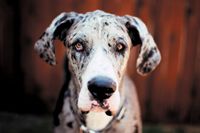Just Ask the Expert: Could you be using lower doses of trilostane in big dogs?
Dr. David Bruyette examines what the studies have to say about this question.
Dr. Bruyette welcome endocrinology questions from veterinarians and veterinary technicians.
Click here to submit your question, or send an e-mail to vm@advanstar.com with the subject line "Endocrinoloy questions."
Q. I have read that it may be better to use a lower-than-labeled dose of trilostane in large dogs that have hyperadrenocorticism. What is your recommendation?

GETTY IMAGES / MARTIN BARRAUD
A. In a recent paper looking at body weight and trilostane dose, there was no significant difference in trilostane dose in mg/kg of body weight or in the total amount of trilostane required daily to control clinical signs, except when the dose for dogs weighing > 30 kg was compared with that for the other groups.1 Statistical comparisons of dose and dosage were made after the dogs were separated into groups weighing < 15 or > 15 kg; groups weighing ≤ 10 kg, 10.1 to 20 kg, 20.1 to 30 kg, and ≥ 30 kg; and groups based on body surface area vs. dose/kg and total amount of trilostane required to control the condition. Despite the lack of statistical significance, there was a trend, suggesting that as body weight increases, the amount of trilostane (mg/kg/dose as well as mg/kg/daily dose) required to control clinical signs decreases.

Dr. David S. Bruyette
The labeled dose of trilostane (Vetoryl—Dechra) is 2.2 to 6.7 mg/kg once a day. I think, in general, that irrespective of body size, we should always attempt to use the lowest possible doses of medication that control clinical signs. This approach also allows us to decrease the frequency of adverse events that may be dose-dependent.
I prefer to start all dogs, regardless of size, at 2.2 mg/kg once a day and then reassess them seven to 10 days into treatment by evaluating clinical signs, measuring electrolyte concentrations, and performing an ACTH stimulation test. I adjust the trilostane dose based on the post-ACTH serum cortisol concentrations in conjunction with clinical signs:
- If the post-ACTH cortisol concentration is < 1.45 µg/dl, I will discontinue treatment until post-ACTH cortisol concentrations are > 9.1 µg/dl. At that point I would decrease the initial dose of trilostane by 50% and repeat the ACTH stimulation test in seven to 10 days.
- If the post-ACTH cortisol concentrations are > 1.45 and < 5.4 µg/dl and the clinical signs are improving, I would continue with the current dose of trilostane and reassess at days 30 and 90 and then every three to four months thereafter.
- If the post-ACTH cortisol concentrations are > 5.4 and < 9.1 µg/dl, I would continue with the current dose of trilostane if the clinical signs are improving and, again, reassess at days 30 and 90 and then every three to four months thereafter. If clinical signs persist, I would increase the dose of trilostane by 25% and repeat the ACTH stimulation test in seven to 10 days.
- And finally, if the post-ACTH cortisol concentrations are > 9.1 µg/dl, I would increase the dose of trilostane by 25% and repeat the ACTH stimulation test in seven to 10 days.
David S. Bruyette, DVM, DACVIM
VCA West Los Angeles Animal Hospital
West Los Angeles, Calif.
Veterinary Diagnostic Investigation and Consultation
Malibu, Calif.
REFERENCE
1. Feldman EC, Kass PH. Trilostane dose versus body weight in the treatment of naturally occurring pituitary-dependent hyperadrenocorticism in dogs. J Vet Intern Med 2012;26(4):1078-1080.
Sweet pee new remedy in feline diabetes
November 9th 2023A novel class of drugs normalizes blood glucose in type 2 diabetic cats by dumping sugar into urine rather than modulating glucose uptake in the tissues but patient selection and close monitoring are crucial to using them safely
Read More